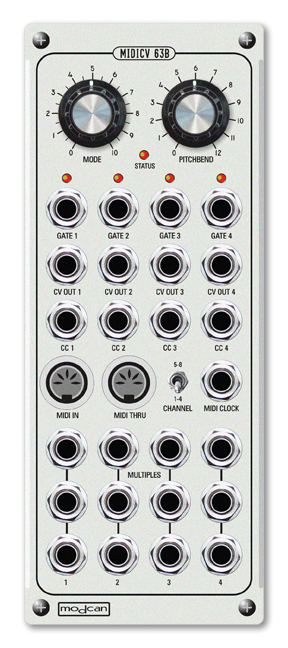-
Home
Welcome to the home of Modcan Synthesizers.
Modcan offers modules in 3 different formats.
A series is the original format with banana jacks.
B Series shares the same circuitry but uses a more
friendly rack sizing and 1/4" jacks.Euro is the newest Modcan format designed for the
Euro Rack format -
A Series
Oscillators
Cases
Filters
Envelopes
LFOs/Logic
FX
Sequencing
CV/Switching
-
B Series
Oscillators
Cases
Filters
Envelopes
LFOs/Logic
FX
Sequencing
CV/Switching
-
Euro Rack
Oscillators
Filters
Sequencer
FX
CV Processing
LFO
Envelope
- Info
- Sounds

The MIDICV 63B module is designed for accuracy, low latency and simplicity of operation, while maintaining a wide range of features in a single width panel.
There are Midi to CV units available from other manufacturers that may offer a broader range of settings and features but as with many such designs they can be obscure and difficult to access and setup. We intentionally set out to create a simple no-nonsense design with preset modes or setups to cover the essential Midi to CV functions suited to a modular system.
The resulting streamlined design is extremely fast with no perceptible latency when played from a keyboard. A high resolution 16bit DAC is used in conjunction with precision low-drift components and temperature compensated voltage reference providing excellent linearity and tracking outputs. The accuracy is measured at better than +/-0.01% (+/-1 cent) over the 10 octave range.
- Features:
- 4 Pitch CV outs 0-10V
- 4 Gates +5V or +10V user selectable set by jumpers
- 4 Continuous Controller Outs 0-5V
- 12 modes of operation (see list below for mode details)
- Pitch bend combined with note pitch on all 4 channels
- Sustain pedal is combined with gate data on all gate outs
- Panel adjustment of Pitch Bend amount
- 2,3 and 4 note polyphonic modes with poly pitchbend
- Pitch range of 10.5 octaves with +/-1 Octave pitch bend
- Arp Style Duophonic mode with improved playability over the original
- 16 bit high accuracy DAC (INL = +/- 3LSB (+/-0.0005V)
- 4 x LEDs for gate status and binary mode indicator (Green)
- 1 x Midi activity indicator LED (Red)
- Midi Clock out divided to 1/16th note for external syncing
- Base Channel switch selectable between Ch1-4 or Ch5-8
- Midi In and thru jacks
- Added Multiple section to utilize panel space
- Low current consumption 65mA@+15V, 10mA@-15V
Modcan MIDI2CV Modes:
Mode 0: 1-channel monophonic with flexible controls & CCs
CV1/Gate1: chl1/5 monophonic with 2-note rollover, no gate re trigger
CV2: Modwheel
CV3: Channel Aftertouch
CV4: Velocity
Gate 2-4: CC65-67 on/off
CC1-4: CC12,13,14,15
Mode 1: 4-channel monophonic with CCs
CV1-4/Gate1-4: chl1-4/5-8 monophonic w/ 2-note rollover, no gate retrig
CC1-4: chl1-4 CC1-4 Modwheel or CC#1
Mode 2: 4-channel monophonic with velocity
CV1-4/Gate1-4: chl1-4/5-8 monophonic w/ 2-note rollover, no gate retrig
CC1-4: chl1-4/5-8 Velocity
Mode 3: 1-channel monophonic with flexible controls & 2nd-channel gates
CV1/Gate1: chl1/5 monophonic with 2-note rollover, no gate re trigger
CV2: Modwheel
CV3: Channel Aftertouch
CV4: Velocity
Gate 2-4: CC65-67 on/off
CC1-4:
chl2/6 C 0/5V
chl2/6: C# 0/5V
chl2/6: D 0/5V
chl2/6 D# 0/5V
Mode 4: 1-channel 2-note polyphonic with flexible controls & CCs
CV1-2/Gate1-2: 2-note poly on chl1/5
CV3: Mod Wheel
CV4: channel aftertouch
Gate 3-4: CC65-66 on/off <--- added
CC1-2: Note1-2 velocity
CC3-4: CC12-13
Mode 5: 2-channel 2-note polyphonic with CCs
CV1-2/Gate1-2: 2-note poly on chl1/5
CV3-4/Gate3-4: 2-note poly on chl2/6
CC1-4: chl1-Modwheel, 12 /chl2-Modwheel, 12
Mode 6: 1-channel 3-note polyphonic with CCs
CV1-3, Gate 1-3 : 3 polyphonic notes/gates
CV4 : Mod Wheel
Gate 4 : CC65
CC1-4 : CC12-15
Mode 7: 1-channel 4-note polyphonic with CCs
CV1-4/Gate1-4: 4-note poly on chl1/5
CC1-4: CC1,12,13,14
Mode 8: 1-channel 4-note polyphonic with velocity
CV1-4/Gate1-4: 4-note poly on chl1/5
CC1-4: 4-note velocity
Mode 9: Duophonic split
CV1-2/Gate1: chl1/5 Arp-style duophonic
CV3: Velocity
CV4: Channel Aftertouch
Gate 2-4: CC65-67 on/off
CC1-4: CC1,12,13,14
Mode 10: All CCs
CV1-4: chl1/5 CC1, 12,13,14
CC1-4: chl1/5 CC 15,16,17,18
Gate1-4: chl1/5 CC65-68 on/off
Mode 11: 1 octave trigger/gates only
CV1: chl1/5 C 0/5V
CV2: chl1/5 C# 0/5V
CV3: chl1/5 D 0/5V
CV4: chl1/5 D# 0/5V
CC1: chl1/5 E 0/5V
CC3: chl1/5 F 0/5V
Gate1: chl1/5 F#-B 0/5V
Gate2: chl1/5 G-B 0/5V
Gate3: chl1/5 G#-B 0/5V
Gate4: chl1/5 A-B 0/5V
CC2: chl1/5 A# 0/5V
CC4: chl1/5 B 0/5V